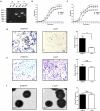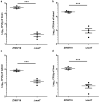The biological role of MutT in the pathogenesis of the zoonotic pathogen Streptococcus suis serotype 2
- PMID: 34077309
- PMCID: PMC8183525
- DOI: 10.1080/21505594.2021.1936770
The biological role of MutT in the pathogenesis of the zoonotic pathogen Streptococcus suis serotype 2
Abstract
Streptococcus suis (S. suis) is an important rising pathogen that causes serious diseases in humans and pigs. Although some putative virulence factors of S. suis have been identified, its pathogenic mechanisms are largely unclear. Here, we identified a putative virulence-associated factor MutT, which is unique to S. suis serotype 2 (SS2) virulent strains. To investigate the biological roles of MutT in the SS2 virulent strain ZY05719, the mutT knockout mutant (ΔmutT) was generated and used to explore the phenotypic and virulent variations between the parental and ΔmutT strains. We found that the mutT mutation significantly inhibited cell growth ability, shortened the chain length, and displayed a high susceptibility to H2O2-induced oxidative stress. Moreover, this study revealed that MutT induced the adhesion and invasion of SS2 to host cells. Deletion of mutT increased microbial clearance in host tissues of the infected mice. Sequence alignment results suggested that mutT was encoded in a strain-specific manner, in which the detection was strongly linked to bacterial pathogenicity. In both zebrafish and mice infection models, the virulence of ΔmutT was largely reduced compared with that of ZY05719. Overall, this study provides compelling evidence that MutT is indispensable for the virulence of SS2 and highlights the biological role of MutT in bacteria pathogenesis during infection.
Keywords: MutT; Streptococcus suis; pathogenesis; virulence.
Conflict of interest statement
The authors declare that they have no competing interests.
Figures





Similar articles
-
Characterization and functional analysis of PnuC that is involved in the oxidative stress tolerance and virulence of Streptococcus suis serotype 2.Vet Microbiol. 2018 Mar;216:198-206. doi: 10.1016/j.vetmic.2018.02.013. Epub 2018 Feb 12. Vet Microbiol. 2018. PMID: 29519516
-
Fibronectin-/fibrinogen-binding protein (FBPS) is not a critical virulence factor for the Streptococcus suis serotype 2 strain ZY05719.Vet Microbiol. 2017 Sep;208:38-46. doi: 10.1016/j.vetmic.2017.07.010. Epub 2017 Jul 15. Vet Microbiol. 2017. PMID: 28888647
-
The non-conserved region of MRP is involved in the virulence of Streptococcus suis serotype 2.Virulence. 2017 Oct 3;8(7):1274-1289. doi: 10.1080/21505594.2017.1313373. Epub 2017 Mar 31. Virulence. 2017. PMID: 28362221 Free PMC article.
-
Streptococcus suis: a re-emerging pathogen associated with occupational exposure to pigs or pork products. Part II - Pathogenesis.Ann Agric Environ Med. 2018 Mar 14;25(1):186-203. doi: 10.26444/aaem/85651. Epub 2018 Mar 2. Ann Agric Environ Med. 2018. PMID: 29575852 Review.
-
Uncovering newly emerging variants of Streptococcus suis, an important zoonotic agent.Trends Microbiol. 2010 Mar;18(3):124-31. doi: 10.1016/j.tim.2009.12.003. Epub 2010 Jan 12. Trends Microbiol. 2010. PMID: 20071175 Review.
Cited by
-
Comparative transcriptomic analysis reveal genes involved in the pathogenicity increase of Streptococcus suis epidemic strains.Virulence. 2022 Dec;13(1):1455-1470. doi: 10.1080/21505594.2022.2116160. Virulence. 2022. PMID: 36031944 Free PMC article.
-
The conserved transcription factor PrlP modulates colonization and pathogenicity of Streptococcus suis in response to environmental stress.PLoS Pathog. 2025 Jul 18;21(7):e1013314. doi: 10.1371/journal.ppat.1013314. eCollection 2025 Jul. PLoS Pathog. 2025. PMID: 40680009 Free PMC article.
-
GrpE and ComD contribute to the adherence, biofilm formation, and pathogenicity of Streptococcus suis.Arch Microbiol. 2023 Apr 1;205(4):159. doi: 10.1007/s00203-023-03503-1. Arch Microbiol. 2023. PMID: 37005968
-
Mechanisms Underlying the Effects of Secretory Protein G22 on Biological Characteristics and Virulence of Streptococcus suis.Microorganisms. 2025 Mar 28;13(4):774. doi: 10.3390/microorganisms13040774. Microorganisms. 2025. PMID: 40284611 Free PMC article.
References
-
- Gottschalk M, Segura M, Xu J.. Streptococcus suis infections in humans: the Chinese experience and the situation in North America. Anim Health Res Rev. 2007;8:29–45. - PubMed
-
- Fittipaldi N, Segura M, Grenier D, et al. Virulence factors involved in the pathogenesis of the infection caused by the swine pathogen and zoonotic agent Streptococcus suis. Future Microbiol. 2012;7:259–279. - PubMed
Publication types
MeSH terms
Substances
LinkOut - more resources
Full Text Sources
Medical
